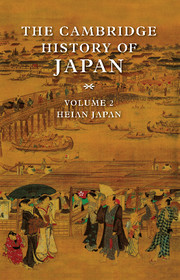Book contents
- Frontmatter
- Introduction
- 1 The Heian court, 794–1070
- 2 The capital and its society
- 3 Land and society
- 4 Provincial administration and land tenure in early Heian
- 5 Chinese learning and intellectual life
- 6 Aristocratic culture
- 7 Aristocratic Buddhism
- 8 Religious practices
- 9 Insei
- 10 The rise of the warriors
- Works cited
- Glossary-index
- Japan in the Heian period"
- References
10 - The rise of the warriors
Published online by Cambridge University Press: 28 March 2008
- Frontmatter
- Introduction
- 1 The Heian court, 794–1070
- 2 The capital and its society
- 3 Land and society
- 4 Provincial administration and land tenure in early Heian
- 5 Chinese learning and intellectual life
- 6 Aristocratic culture
- 7 Aristocratic Buddhism
- 8 Religious practices
- 9 Insei
- 10 The rise of the warriors
- Works cited
- Glossary-index
- Japan in the Heian period"
- References
Summary
ORIGINS OF THE WARRIORS
The term for the Japanese warrior, bushi (“martial servitor”), which became common from the late Heian period on, was preceded in earlier centuries by the words tsuwamono and musha. Bushi, like the other two words, specified the professional warrior as distinguished from peasant conscripts, court military officials, and palace guards. Tsuwamono is a native Japanese noun of unknown morphology, and musha (or musa) a Sino-Japanese binom meaning “martial one.”
The professional warriors were private fighters who at first fought entirely in their own interests and for their own ends. They later entered the personal retainerships of court nobles or, more commonly, military lords, the greater of whom were called tōryō, another Sino-Japanese word, the constituents of which denoted “rooftree and rafters,” that is, the chief members of a roof and, by extension, also “chief person.” The term was commonly used to mean the chieftain of a major clan or family. As private fighters, the tsuwamono were fundamentally different in character from government troops, who were conscripted by authority of the state and fought solely for it.
During the seven hundred years from the twelfth century to the nineteenth, Japanese society was dominated by warriors, who first appeared as a potent independent political force in the country at the time of the revolt of Taira no Masakado in the mid-tenth century. Masakado and many of his supporters and opponents were professional fighting men, mounted archers descended in their skills perhaps from the prehistoric hunters found in the archaeological record of the eastern provinces.
Keywords
- Type
- Chapter
- Information
- The Cambridge History of Japan , pp. 644 - 709Publisher: Cambridge University PressPrint publication year: 1999
References
- 6
- Cited by

